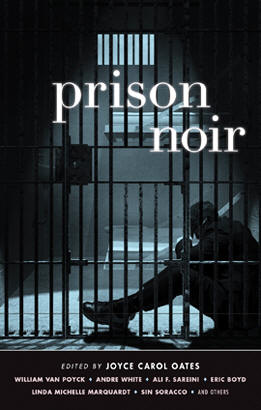|
Prison Noir
edited by Joyce Carol Oates
c.2014, Akashic Books
$15.95 / $19.50 Canada
259 pages
By Terri Schlichenmeyer
The Truth Contributor
Three-and-a-half steps.
Visualize it: that’s how big your home is. Back against the
wall, three-and-a-half steps until you can’t go anymore.
Arms straight out at your sides, fingers touching both
walls, cement floors. Hardly a palace.
Now you head outside any time you want, day or night, to do
what you want to do. But picture bars on your doors and
someone telling you when to eat and when to sleep. Then grab
the new book Prison Noir, edited by Joyce Carol
Oates, and read other tales of doing time.
|
 |
|
Imagine the difficulty of choosing the best 15 of a 100
exceptional prison stories, a challenge that faced
author-editor Joyce Carol Oates in pulling this book
together. That the entries she read were “well-crafted”
should be no surprise; after all, each of them was written
by someone who is or has been in prison, which lends a
“disconcerting ring of authenticity” to tales like these.
You know if you’ve been incarcerated, for instance, that
having cellies can be a thorny issue, but in the first
story, “Shuffle” by Christopher M. Stephen, even segregation
doesn’t mean “true solitary confinement” anymore.
Yes, roommates and block mates can be trouble – but they can
also keep a person sane, as in “I Saw an Angel” by Sin
Soracco. Conversely, as in “Bardos” by Scott Gutches, the
person two cells down can make you really think – especially
when he’s dead just shy of his release date.
In prison, there is no privacy. There is no escaping the
sound of the echoing clink of “hundreds of doors closing at
the same time.” There can be language barriers that lead to
huge misunderstandings. In prison, as in “Milk and Tea” by
Linda Michelle Marquardt, there are people just trying to
get by and get beyond a crime that surprised even them. And
behind bars, there’s danger – not just to others but, as in
“There Will Be Seeds for Next Year” by Zeke Caliguiri,
there’s danger to the inmate himself…
In her introduction, Joyce Carol Oates says that there were
some stories in this anthology that she read multiple times,
and she admits that there were others she didn’t quite
understand. She calls them “… stark, somber, emotionally
driven… raw, crude, and disturbing material…”
And she’s right. But she forgot the word “riveting.”
Indeed, it’s hard to turn away from what you’ll read inside
Prison Noir. There’s sadness here, frustration,
resignation, and a surprising sense of slyness. You’ll find
fiction, perhaps, or maybe it’s all real – possibilities of
which you’ll squirmingly have to remind yourself. Either
way, the 15 contributing authors didn’t seem to be holding
anything back which, for the right reader, can be some
powerful seat-glue.
Beware, before you pick up this book, that it’s filled with
exactly what you’d expect from prison literature. I enjoyed
it quite a bit, but I wouldn’t begin to call it nice. With
that caveat in mind, I think that no matter what side of the
bars you live on, Prison Noir is worth doing time
with. |